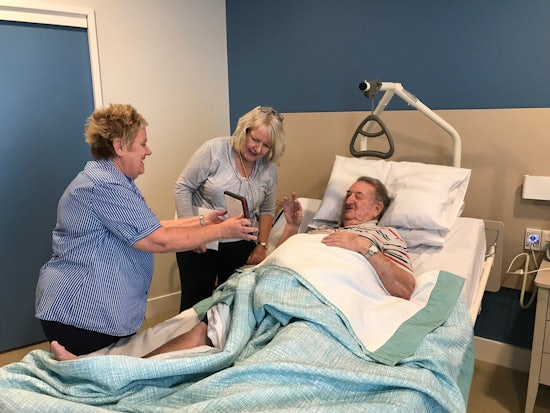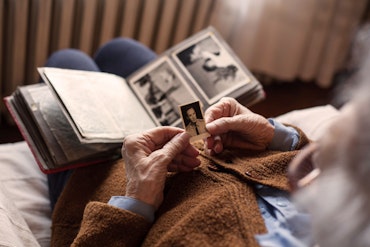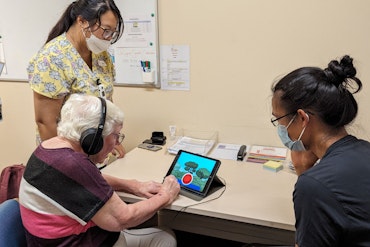Technology trial successfully takes aim at reduced hospital admissions
The role of technology in health and aged care has long been acknowledged, but a partnership between a New South Wales hospital and aged care provider has proved that its impact could be much more far-reaching than first thought.

A recent trial proved Telehealth to be a “valuable visual tool” (Source: Anglican Care)
Belmont Hospital teamed up with five Anglican Care aged care facilities over 18 months ago to trial Telehealth – a project which uses telecommunications technologies to distribute health-related services and information.
Over the 18 months, the trial aimed to reduce hospital admissions from aged care facilities to the emergency department, and in turn avoid hospital re-admissions, as well as enhancing the clinical handover of information between both the acute care and aged care sectors by giving the option to provide visual assessment without the resident having to leave their familiar supportive environment.
Anglican Care Nurse Practitioner Janean Cole says the trial proved Telehealth to be a “valuable visual tool” and says that it achieved the goals set.
“Telehealth is a valuable visual tool for clinicians supporting residential aged care facilities to get the right care in the right place at the right time for elderly residents,” Ms Cole says.
“Residential aged care facility registered nurses value the visual input on their residents on discharge from hospital [and] the collaboration between acute care and aged care nursing staff has increased, leading to early discharges of complex patients reaching the end of their life.
“We considered the project a success as it has provided appropriate care for our residents in their own living environment.
“Since the completion of the project, Hunter Area Health – John Hunter Hospital – has introduced Telehealth.
“At Anglican Care we continue to expand the use of Telehealth in our organisation as all our facilities have access to Telehealth to connect with specialists appointments, hospitals as well as across other Anglican Care sites.”
Ms Cole highlights that the use of technology like Telehealth is crucial because of the benefit it has on elderly residents.
“Hospital stays for the elderly can have a detrimental effect on their wellbeing,” she explains.
“They are out of their familiar environment and frail and this can increase the risk of delirium, falls, medication errors, pressure injuries and deconditioning.”
Anglican Care Senior Nurse Educator Janet Sykes says a lot of work went into making the project a success and notes a number of challenges overcome along the way.
“Anglican Care had five facilities involved in the project, so numerous education sessions were provided at each site on how to join a meeting and go through Telehealth protocol,” she explains.
“Hands-on support was provided for the first few Telehealth calls until staff felt comfortable.
“Initial challenges included the staff accepting the new mode of handover and communication – they perceived it as being too time consuming due to changes in staff practices with a different communication mode.
“Staff had resistance to change as they thought the technology was hard to use, unnecessary and had limited value.
“Some staff were screen shy and felt uncomfortable about having their face on screen, so practice calls between facility and hospital became more frequent and Telehealth was used for meetings between all Anglican Care facilities where possible to show Telehealth as a ‘norm’.
“Staff did become more comfortable, but this is something we have identified that requires ongoing education.
“Training was provided to staff, which is when we decided to make the move from a laptop and dongle to iPad, it was then that staff saw the simplicity of connection with Telehealth and as a result, staff uptake increased.”
As well as all of the training and education, monthly meetings were also held with all stakeholders to discuss and collaborate with process, execution and outcomes.
“During the meetings, we discussed any issues with technology, barriers identified, potential results and any education/improvements required for staff to take up the Telehealth option,” Ms Sykes explains.
Overall, both Ms Sykes and Ms Cole say the program has improved the quality of handover from hospital to emergency departments, and allowing greater participation of family and carers.
“26 Telehealth calls occurred with regular partnership meetings, resulting in a 30 percent reduction in emergency department presentation,” they say.
“From May 2016 to October 2017, 43 reverse Telehealth calls were made from acute care to aged care, and 8 Telehealth calls were made from aged care to the emergency department.
“There were no emergency department presentations within 48 hours and no admissions to hospital within 28 days of the Telehealth calls and no aged care Telehealth patients died in the emergency department.
“We see more opportunities for the use of Telehealth and will continue to educate and promote its implementation to become a standard option for care delivery and communication.”
As well as seeing an uptake from within those involved in the trial, Ms Cole says the aged care and health care industries have shown “great interest” in the results of the Telehealth project and as a result, a similar initiative has been set up between other organisations.
“There are a number of specialists now engaging in Telehealth,” she says.
“Other organisations have been in contact with Anglican Care to discuss how they can implement the system and find out what’s involved.”























